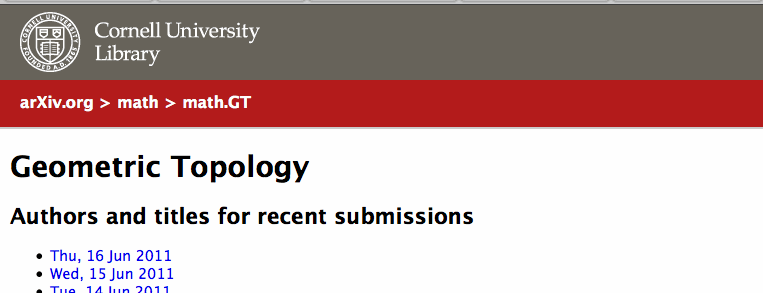By Laura Zirbel
So you want to keep up with the current research in your field? Google reader is a great way to manage the influx of articles, and skim a wide range of topics that may be useful for you, as well as reading blog posts like this one.
The first step is to sign up for Google reader.
Each topic and subtopic on the archive has an rss feed that allows you to subscribe, in Google reader, and receive all new articles posted in that area. Suppose I wanted to subscribe to the Geometric Topology feed.

The path in the red bar is what I need. Whatever the last location is (in this case, math.GT) is what I add to the URL http://arxiv.org/rss/ to obtain http://arxiv.org/rss/math.GT.
Now, we’ll add this feed to our Google reader by clicking the “Add a subscription” button in the top left corner, and typing in the URL http://arxiv.org/rss/math.GT. And we’re done!

But maybe you don’t want EVERY article from EVERY subtopic that applies to your research. Say you research Coxeter groups. A quick search on the arXiv shows that “Coxeter” shows up in the suptopics of Mathematical Physics (math-ph), Group Theory (math.GR), Quantum Algebra (math.QA), and many more. I need to create a filter that allows me to only receive the articles that contain the word Coxeter.
You can’t currently do this through the arXiv. But it’s easy to set up a filter through a third party. I used http://feedrinse.com, a free and user friendly site. After making an account, you add the rss feeds you wish to filter in the same way you did in Google reader. Click the “add feed” button, and add the URL (or several URLs at once) and click “import.”

Now we can create a filter for that feed. Under the “your feeds” tab, you can select the rss feed, and add rules. For example, we want to only allow posts that contain the word Coxeter. You can make as many rules as you’d like.

After saving, click the “Get your rinsed feeds” button at the top. Export your feeds, which will be an opml file. To add these filtered feed to your reader, click the gear icon in the top right corner of Google reader and go to “Reader settings.” Go to Import/Export and upload the opml file you just downloaded. When you go back to the main Google Reader page, you’ll see your unread articles under subscriptions.
You can also create a filter for the arXiv main feed, looking for the word Coxeter, which may be easier than adding each subtopic one at a time.
If you keep Google reader open, it will refresh often, just like gmail. You can also use it to share interesting articles with others in your research group, by using the “share,” “share with note” and “email” buttons at the bottom of each item.
